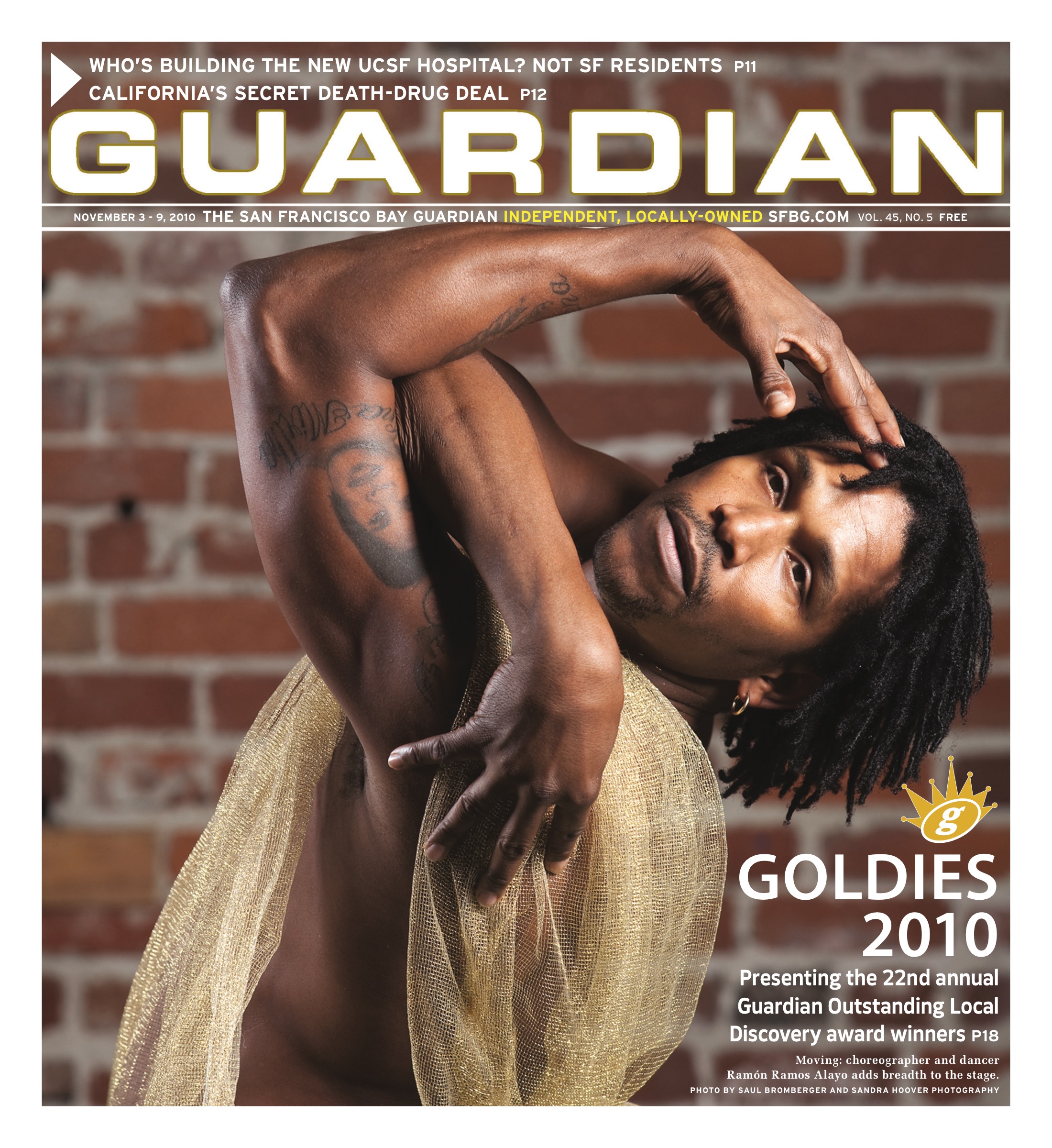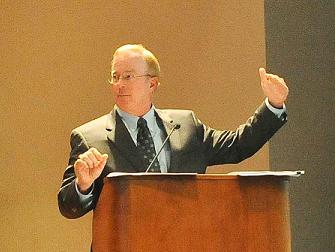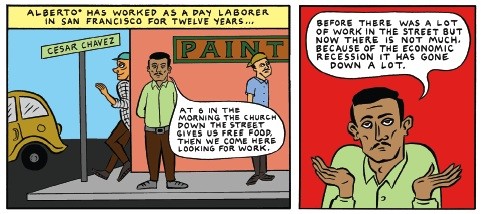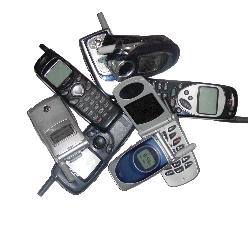› gwschulz@sfbg.com
Accused illegal arms dealer Victor Bout’s long-awaited arrest by Thai police officers March 5 was an important victory against unchecked human rights abuses around the world, and a personal vindication for the San Francisco woman who helped bring Bout to international attention.
Bout arrived at the luxurious Sofitel Hotel in Bangkok believing he was to meet with two senior leaders of the Marxist guerrilla army known as the Revolutionary Armed Forces of Colombia, or FARC. The men, it turned out, were paid informants operating on behalf of US drug enforcement officials.
Through an associate, the 41-year-old Bout allegedly promised to sell the duo large quantities of weapons to continue FARC’s decades-old insurgency against the Colombian government. According to an April federal grand jury indictment filed in New York, the arms included surface-to-air missiles, AK-47s, C-4 explosives, land mines, and even people to help train FARC soldiers in using the weapons.
Among those most relieved — and surprised — at the arrest was a relentlessly determined human rights investigator who lives in San Francisco. Kathi Lynn Austin, 48, has been pursuing the notorious trafficker and war profiteer for more than a decade.
Bout, a former USSR Air Force officer, is widely reputed to be one of the world’s most active criminal arms dealers, perhaps best known for his spectral presence on the African continent. There, he cultivated professional relationships with its litany of brutal dictators and helped fuel some of the most appalling human rights tragedies of the last century.
Austin and other investigators, as well as journalists and law enforcement officials in several countries, say that Bout expertly structured a business empire of shell companies, dubiously licensed cargo planes, and endless arms accumulations from former Soviet stockpiles — all of which were intended to minimize evidence linking his name to illegal weapons dealing.
But the work Austin did to penetrate that shell and expose Bout was so notable and dramatic that Paramount Pictures announced in December 2007 that superstar Angelina Jolie would play her in a drama inspired by Bout’s infamous career.
It’s a stunning achievement for someone who 15 years ago struggled to convince even her colleagues in the human rights community that the end of the Cold War and the globalization of organized crime made nonstate actors like Bout as much of a threat to peace as the tyrannical governments they’d been naming and shaming for years.
"A human rights violation is considered a violation that is carried out by a state actor," Austin told the Guardian. "We were trying to change the whole field of human rights to philosophically say we should be going after these private perpetrators as well."
Austin has helped document Bout’s convoluted network since about 1994, first as a consultant for Human Rights Watch and later as arms and conflict director for the Washington, DC–based Fund for Peace, for which she maintained a San Francisco office, before eventually working for the United Nations.
After returning to San Francisco in June from an 18-month UN mission in East Timor, Austin agreed to talk about her investigations of Bout over several hours of interviews near the North Beach apartment where she’s been holed up writing material for the Paramount script.
Seeing Austin in a crowded coffee shop with clear features and wide, earnest eyes, it’s not easy to imagine her charging through the world’s hellholes: Rwanda, Sierra Leone, Liberia, the Democratic Republic of the Congo, Angola, and other African conflict zones where the UN has imposed longstanding but ineffective arms embargos.
The work of Austin and others repeatedly helped show that death and destruction could continue indefinitely for the right price paid to savvy arms brokers like Bout, while the United States failed to regard the plight of civilian populations across Africa as vital to its interests.
As the world would learn in 2004, even the US military relied on Bout’s planes to conveniently bring its partially privatized war machine down on Iraq, making this story about more than just Bout and his pursuers.
Following Bout’s arrest in Thailand, federal prosecutors here charged him with conspiring to kill US nationals and attempting to illegally acquire anti-aircraft missiles.
In 1997 the United States designated FARC a terrorist group for kidnapping and murdering American citizens in Colombia. US officials also consider Colombia the globe’s largest supplier of cocaine, a trade that’s kept the leftist rebels afloat.
Bout allegedly told DEA informants that an ongoing, violent campaign by the FARC to counter America’s cocaine fumigation efforts in Colombia was his fight, too, and that he could supply the guerrillas with everything they needed.
Days after this story goes to press, however, he’s due for a court hearing in Bangkok, where a judge will decide whether to extradite him to the United States. That means Bout could face a criminal trial on American soil. To Austin, that’s long overdue. She had lost hope that her country would subdue a top-tier enabler of gross human rights violations. A secret sting operation led by American narcotics agents was the last thing Austin believed would lead to Bout’s capture — and for good reason.
She first became aware of his name in 1994, shortly after witnessing one of the brightest moments in contemporary African history. On April 24 of that year, Austin stood near the polling station as Nelson Mandela, a political prisoner of 27 years, marked his ballot in South Africa’s first fully democratic election. She’d been invited to attend after working as a researcher in the Natal province documenting political violence and the apartheid government’s desperate attempts to preserve decades of white control through upheaval and destabilization. No one was sure Mandela would reach the ballot box.
"We got up at three, four in the morning to load a bus," Austin recalls. "Nobody told us exactly where it was. We had to go under cover of darkness. When we got there, he voted just after the sun came up."
The inauguration party weeks later spilled out everywhere in Johannesburg. Austin mingled with foreign journalists and drank champagne. But one of the greatest parties of the century turned glum as vague reports mounted describing trouble in a nearby country, one smaller than Maryland and at the time unknown to most Americans: Rwanda.
"Nothing was really clear. It was all very ambiguous," Austin remembers. "We just kept hearing these reports that 10 Belgian peacekeepers had been killed and the UN was pulling out and people were dying on a massive scale."
The Rwandan genocide would become one of the greatest human atrocities since the Holocaust as extremists from the ethnic Hutu majority massacred at least 800,000 minority Tutsis and Hutu moderates with gruesome efficiency while the world stood by.
As details emerged, Austin raised money in the United States and worked to get to the beleaguered African nation as soon as possible. Meanwhile, a Tutsi-led military offensive defeated the Hutu Power government in the capital city of Kigali by July 1994 and supposedly ended the genocide. But as Austin and others would learn, the violence was far from over.
Hundreds of thousands of refugees streamed toward the eastern border of neighboring Zaire, among them the perpetrators of the genocide. Hidden inside refugee camps, Hutu militias renewed their strength and began amassing weapon caches with the quiet support of Zairian dictator Mobutu Sese Seko.
Austin fearlessly penetrated the militia encampments, persuading exiled Hutu military leaders to disclose how they had obtained antitank grenades and high-caliber ammunition. The list included Col. Théoneste Bagosora, considered to be a chief architect of the genocide. Her trick? Austin told them she was a researcher for the neutral-sounding Institute of Policy Studies — which was technically true — and simply needed to hear their side of the story.
"It was a really treacherous place to be," Austin said. "At the time I appeared young, nonthreatening. I didn’t often say I was with Human Rights Watch…. In any kind of organization, people are motivated by many different things. You find those sources that for some reason or another want to help out or are so ego-driven they don’t think that any information they give to you is going to be used somehow against them."
She also interviewed members of flight crews who gave her information on cargo companies hired by the Mobutu government to secretly supply its Hutu allies with weapons by falsifying official flight plans and end-user certificates, key legal requisites designed to curtail transnational arms shipments.
According to her later Human Rights Watch report, "The militias in these camps have taken control of food distribution, engage in theft, prevent the repatriation of refugees through attacks and intimidation, carry out vigilante killings and mutilations of persons suspected of crimes or of disloyalty … and actively launch cross-border raids."
What didn’t make sense was how the suspected ringleaders of the genocide could obtain weapons despite the return of peacekeepers to the area and an arms embargo on Rwanda imposed by the UN.
CIA investigators later discovered that planes belonging to Bout were involved in supplying the outlaw Hutus, according to Douglas Farah and Stephen Braun’s definitive book on Bout, Merchant of Death: Money, Guns, Planes, and the Man Who Makes War Possible (Wiley, 2007).
Austin also came to that conclusion by the end of an eight-month fact-finding trip to the region carried out in 1994 and 1995. Her findings for Human Rights Watch helped propel her to international notoriety as more NGOs focused on illegal arms flows coming from private brokers.
"The Rwandan genocide was really the watershed, for me and for Bout," Austin said. "In the early years, he’s building his empire and I’m beginning to narrow what I want to investigate. I was becoming more and more convinced that in all the wars I was looking at, it was logistics. It was all about who could bring in the guns, the fuel — keep the war going."
Back then, Bout was still a bit player among many weapons suppliers working on the continent, according to Austin. But he soon did something that would significantly boost his career and help make him what another Bout pursuer once described as "the McDonald’s of arms trafficking." He switched sides and helped the new post-genocide Rwandan leadership topple the neighboring Zairian presidency of Mobutu, Bout’s own longtime client.
Zaire is known today as the Democratic Republic of the Congo. Bout would make yet more money years later aiding another warlord who attempted a violent coup inside the country, Jean-Pierre Bemba. The International Criminal Court last month charged Bemba with mass brutality and rape committed against civilians between 2002 and 2003.
"He [Bout] has no loyalty," a Bout associate told Merchant of Death authors in 2006. "His loyalty is to his balls, his sweet ass, and maybe his wallet."
Probably Bout’s most cynical move occurred in Afghanistan. At the start of his career, in the early 1990s, he allegedly maintained an intimate business relationship with commanders of the Northern Alliance, the tribal army that fought Taliban extremists for years until gaining power in Afghanistan with US help following the Sept. 11 terrorist attacks.
US officials began openly acknowledging in 2005 that Bout earned as much as $50 million also furnishing the Taliban with military equipment during its reign over the country.
Austin’s upbringing is the antithesis of what one might expect from an international human rights investigator. The oldest of five kids, she played guitar in a country-and-western band with the rest of her siblings, embarking on tours throughout the South from their home in Richmond, Va.
"We would play for people who had no money," she said. "We’d camp out for three days just to give them some music."
In the ’60s , the family of Baptists played at small African American churches during the climax of Southern segregation and against the backdrop of racist terror. They defied the neighbors and invited black friends over for dinner or socialized with them publicly. The Austins were largely apolitical, but Kathi says her parents insisted on human decency and encouraged a basic sense of justice and rebellion.
Her exposure to the destitution of many formerly enslaved black families in the South translated seamlessly in her own mind to Africa, a continent that fascinated her. But her understanding of the continent was limited.
"I just wanted to go save Africa one day. It was what I said I wanted to do with my life when I was really young…. I had this kind of missionary zeal, this very naïve, humane impulse."
Few people in her family considered going to college, but Austin hungered for academic achievement, securing a scholarship to the University of Virginia in the late ’70s.
Civil rights turmoil at the school politicized her and transformed her deeply. A model Organization for African Unity held for college students each year at Howard University in Washington, DC had the greatest impact. She attended it devotedly for several years. After competitive debates, politicians, professors, and other experts would speak to the students about Africa’s colonialist history and the anti-Apartheid movement.
"I really began to understand a lot of the underpinnings of what was going on with the African liberation movement in South Africa," she said. "I became engrossed in it and learned a lot intellectually and got a good sense of what I thought."
Austin began to zero in on the Ronald Reagan administration’s agenda of undermining Soviet communist influence in the region. The United States covertly backed the UNITA rebels in Angola against a communist-led liberation movement there, and continued to support the white-dominated and separatist apartheid regime of South Africa.
She wanted to investigate the unsavory relationships Reagan’s White House had developed on the African continent in its crusade to defeat communism during the Cold War. But Austin was aware of only two think tanks in the capital that examined such issues and had a reputation for attracting left-leaning luminaries. One was the nonprofit National Security Archive, a repository of declassified intelligence and foreign policy documents obtained largely through Freedom of Information Act requests.
Headquartered at George Washington University, lawmakers concerned about US covert activities abroad and some of the nation’s best-known journalists, including New Yorker writer Seymour Hersh, palled around at the independent, nongovernmental research library after it was founded in 1985 by a group of muckracking reporters and scholars.
Austin’s internship there in 1988 created a new realm of possibility — solo investigations — and sparked an interest in following the intricate paper trails that accompanied her growing knowledge of Africa’s geopolitical landscape, frequent outbreaks of low-intensity conflicts, and evasive weapons procurers.
But she still had never been to Africa. "That was my big ambition," she said. "If there’s anything about me it’s that I’ve got to see for myself."
As her ties to Washington expanded, she joined a World Bank urban rehabilitation team, writing political and economic background reports on Angola in 1989, believing she could make a difference inside the ill-reputed lender to developing countries.
She didn’t, but it was enough to give her first contact. After that trip to Angola, Austin used her savings to stay behind, joining a UN mission overseeing the withdrawal of Cuban troops above the 19th parallel, who were there as a result of Angola’s years-long civil war. She later went to Mozambique on a MacArthur Foundation grant and interviewed private mercenaries operating there for a report called "Invisible Crimes" that included a simple investigative formula she would employ for years to come: What’s wrong? And who’s doing it?
"Through the years, you realize just what kind of danger she’s in," her sister, Cindi Adkins, said from Virginia. "We would go days, weeks, months without hearing from her. My mom would say, ‘We have to call the Red Cross and see if we can find out that she’s okay.’<0x2009>"
Wanting to escape Washington culture, she moved to North Beach in 1997 after becoming entranced by San Francisco’s slower pace. Between missions, she’d spend full days at Caffe Sapore on Lombard Street writing a book about arms trafficking she’s still working on today.
Stanford University’s Center for African Studies invited her to become a visiting scholar for a year, researching arms proliferation and lecturing students, while the Goldman School of Public Policy at the University of California, Berkeley, did the same thing shortly afterward.
But the San Francisco–based Ploughshares Fund became one of Austin’s biggest supporters, helping her finance the creation of a local arms and conflict office for the Fund for Peace, an antiwar think tank in Washington.
"At that time, one of the areas we did a lot of funding in was the control of small arms and light weapons," said Deborah Bain, Ploughshares’ communications director. "Kathi was someone who did a lot of very courageous work tracking arms flows around the world. We were very impressed with the work she was doing and the kinds of results she was getting."
By then the UN had grown to understand the need for knowledgeable people on the ground who could travel across various war-torn African countries and gather evidence on who was vioutf8g arms embargos and how they were doing it. In the coming years, Austin served as a consultant and official expert on panels that investigated sanctions violations in Liberia, the Congo, Uganda, Burundi, Sudan, and Sierra Leone with teams of other human rights investigators who’d long followed Bout’s operations.
Her ex-boyfriend, Todd Ewing, a foreign economic development specialist and Bay Area native who began dating her in East Africa during the ’90s, described Austin as intense and ambitious. While his own blonde hair and six-foot frame made him conspicuous in the region, he said Austin’s "big brown eyes" and polite manner enabled her to slyly convince gritty characters to talk.
"Her MO at that time would be to just disappear for months [on fact-finding trips]," Ewing said. "I always liked to describe her as a sort of spy for the good guys."
Observers say that history handed the equally ambitious Victor Bout a perfect storm in 1991 at just 24 — an age when many Americans are looking for their first post-collegiate job.
The Soviet empire dissolved that year, ending the Cold War between Russia and the United States. Economic globalization expanded and gave every creative entrepreneur with good connections, criminal or legit, a chance to make a fortune. Aging Cold Warriors in the Beltway during the Bill Clinton era and later in George W. Bush’s cabinet maintained a stark binary ideological view of the world and failed to take seriously the growing threat posed by transnational criminals who had exchanged ideology for profit.
After the Berlin wall fell, corrupt Russian oligarchs infamously plundered the country’s assets as they were privatized following years of state control. Some robbed Russia’s rich oil reserves. Bout sought its military installations and airfields containing rows of cheaply available and unused commercial planes, all essentially abandoned by the central government.
Profiles of Bout put him in Angola — and possibly Mozambique — working as a translator for Russian peacekeepers when the Soviet Union broke up. US officials say Victor Anatolijevitch Bout was born in Dushanbe, Tajikistan, a deeply impoverished former Soviet state, and speaks several languages.
Bout told the New York Times in a rare 2003 interview that he purchased three Antonov aircraft for next to nothing in 1992 and used them to exploit a gap in the transit market, at first ferrying innocuous cargo like flowers from South Africa to the Middle East.
But the mogul quickly fostered connections to old Eastern bloc manufacturing and storage facilities in places like the Ukraine and Bulgaria, which were filled with AK-47s — ubiquitous in the developing world — ammunition, tanks, helicopters, and other military equipment.
Over time, investigators say he erected a complex web of cargo and airline companies designed to throw off suspicion. If one firm faced too much attention from aviation authorities, another was created to hold the assets. Otherwise, bribery, fraud, and forged documents were used, according to a report on Bout created by the US Treasury Department. In many African countries, aviation regulations are weak and international law is rarely enforced.
"Unless confronted with documentary evidence to the contrary, Bout’s associates consistently deny any involvement with Bout himself or playing any role in arms trafficking," the treasury report from 2005 reads.
US officials believed by then that he controlled the largest private fleet of Soviet-era aircraft in the world and employed hundreds of people, overseen partly from a nerve center in the United Arab Emirates, at the time a fast-growing and highly unregulated intercontinental transportation hub east of Saudi Arabia.
The Treasury report and other investigations say Bout became a confidante of the Liberian dictator Charles Taylor, supplying him with gunships and missile launchers. Taylor is currently on trial in the Hague for directing horrifying atrocities in neighboring Sierra Leone, ranging from widespread and extreme sexual violence to drugging and forcing children into combat.
When treasury officials here finally moved to seize Bout’s assets and bar Americans from doing business with him in 2004, they concluded that he had received diamonds extracted from Sierra Leone in exchange for supplying arms to Taylor.
That year saw one of Austin’s boldest attempts to confront the trafficking of illicit goods, on an airport tarmac in the Democratic Republic of the Congo, at that time under its own arms embargo. A UN team Austin worked with uncovered piles of questionable registration records during a surprise inspection of two dozen planes, some of which fit Bout’s profile, as their Russian crews stood by, annoyed.
"I only told one or two high-ranking UN officials to get their permission, so we could be sure it didn’t get leaked out," Austin said. "None of the people involved in the actual inspection knew about it until that morning…. I’m still surprised it was so effective. I’m not sure it would work again."
International aviation rules require pilots to maintain several different types of documents, but the group found that 21 planes had invalid registration papers, two had false airworthiness certificates, and three had no insurance to speak of — telltale signs of smuggling. The group determined that weapons in the area were being exchanged for illegally mined columbite-tantalite, or coltan, a valuable mineral contained in some modern electronic devices such as cell phones.
The revelation led the UN Security Council to place Douglas Mpamo, a prominent alleged Bout manager in the region, on the DRC sanctions list, along with a pair of well-known Bout subsidiaries. With Austin’s help, another reputed top Bout lieutenant named Dimitri Popov made a similar security watch list in the United States.
Meanwhile lower-level bureaucrats in the US State and Treasury departments collected evidence on Bout for years, assisted by Austin, who occasionally met with them to relay information she had gathered on fact-finding missions. She testified to Congress about the proliferation of small arms, too, but after Sept. 11, the White House drifted away from a growing campaign to stop Bout.
"I don’t think the Bush administration should get any credit for the fact that Victor Bout was arrested," Austin said. "I think it has to do with the DEA being insulated from the policy influences of the administration. They kept the case so secret they were able to succeed. In the past, once it became an interagency issue or problem, bureaucratic inertia and turf wars entered in and always raised some obstacle to the actual pursuit of Bout."
Eventually, that bureaucratic inertia began to look like something far more shameful.
On April 26, 2005, several state and federal law enforcement agencies including the FBI, IRS, and Dallas Police Department, raided two homes and an office in Richardson, Texas, looking for evidence that Bout’s tentacles had reached the United States.
The properties belonged to a Syrian-born American citizen named Richard Chichakli, who had served in an aviation regiment of the US Army during the first Gulf War. After being discharged in 1993, Chichakli helped create a free trade zone in the United Arab Emirates.
That’s where Chichakli likely first met Bout. Chichakli later returned to the US and became licensed as an accountant and an expert in military contracting. Officials found records showing that the 49-year-old Chichakli had created American companies connected to Bout.
Also discovered during the raid were wire transfer statements showing hundreds of thousands of dollars at a time moving from Bout-connected companies in the UAE to Chichakli in Texas, and credit card invoices managed by Chichakli listing Bout’s lavish purchases at businesses serving the nouveau riche of Moscow.
The raids were the result of a July 2004 executive order signed by President Bush — who, facing pressure from the UN, authorized the raids and prohibited Americans from doing business with Bout due to his connections to Taylor in Liberia.
The White House’s action came years after Austin and other investigators compiled their own research on Bout’s role in arming African warlords. Thirty companies and four individuals were added to a blocking order as a result. Federal court records from the case include extensive references to UN reports on Bout, including some Austin worked on, like one citing witnesses who saw a Bout-connected plane transporting large volumes of arms and ammunition through a Congolese airport between February and May 2004. Something was finally being done, or so it seemed.
But Austin and her colleagues were furious to learn that the US Defense Department hired Bout’s vast air armada with taxpayer money nearly 200 times in 2004 alone to ferry supplies and construction materials into Baghdad after the start of the Iraq war.
Merchant of Death co-author Braun, a Los Angeles Times national correspondent, reported for the paper in December 2004 that two well-established Bout companies, Air Bas and Irbis, had contracted with the US Air Force and Army as well as private companies like FedEx and Kellogg Brown & Root, the much-maligned former Halliburton subsidiary. The State Department had circulated a list of Bout companies warning its officials not to use them, Braun wrote, but the Pentagon made no similar effort.
A fuel purchase agreement included in Chichakli’s court file shows that the Defense Department used Air Bas "for official government purposes" just nine days after Wisconsin Democratic Sen. Russ Feingold questioned top defense officials, including then–Deputy Secretary of Defense Paul Wolfowitz, about such contracts. But Wolfowitz didn’t acknowledge what he eventually characterized as the "inadvertent" use of Bout’s planes for Feingold until months later.
When Austin delved into the issue in 2005 with fellow Merchant of Death author Farah, a former West African bureau chief for the Washington Post, the pair obtained new information for an article in the New Republic showing that the US military also used Bout-controlled companies during a four-month period in 2005, long after the "inadvertent" contracting had first been publicized.
The discoveries were a major letdown for Austin. She’s discussing with some NGOs the possibility of suing the federal government for vioutf8g its own presidential executive order. But Austin knows that even if Bout lands in a US prison for life, there will be someone else to take his place. It’s already happening, she says. As dark as it sounds, Austin will never have to go without a job.
"I’ve seen so much of the same thing go on year after year," Austin said. "You just have to take it in stride and keep coming back punching and hitting. That’s just the nature of the beast, the nature of the work that I do. You just have to keep going."














